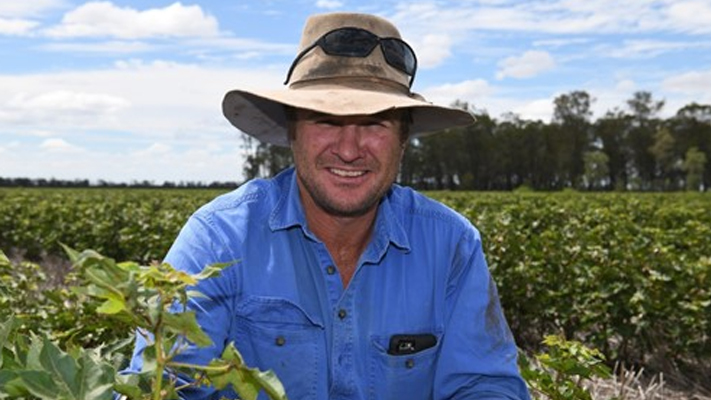Better utilisation of moisture with cotton on Boomi property
About
-
Category
- News
- Grower Stories
- Video
-
Date
11 September, 2018
-
Location
Boomi, NSW
About
Category
- News
- Grower Stories
- Video
Date
11 September, 2018
Location
Boomi, NSW
Cotton has become a major summer crop in recent years on the Moloney’s property at Boomi due to the way it utilises moisture.
Ben Moloney, who farms at “Waverley” north of Moree in northern NSW, said their main summer crop had always been sorghum, but in the past two years they also planted cotton.
“We quite like cotton because the water use pattern is different to sorghum and it is a good broad-leaf break for grass weed control.”
He said traditionally the major rainfall months in the area were January and February so a later planted or longer season crop, such as cotton, could benefit from those events.
“It will take advantage of that moisture more so than a September-planted sorghum. And it’s plant that can handle heat.
“You always hope to get that January-February rain. They are generally our more reliable months.”
Mr Moloney said they received advice from a private consultant in Goondiwindi and, with good rain in October, planted the cotton early the following month.
“They guided me through exactly what you have to do but I find it is quite an easy crop to manage.
“With Bollgard 3 coming now, obviously insect pressure is not there like it used to be. The staple length of the cotton is a lot better than it used to be too which makes it better for dryland.”
The cotton was planted in a three-metre double-skip configuration at a rate of 12 seeds per metre and established at seven plants per metre.
Both years of cotton on the property have been challenging but the crop has shown an ability to survive through the tough conditions.
“It certainly has more up-sides than sorghum, but obviously the costs are higher too,” Mr Moloney said. “I certainly think it is going to become more common in the black, heavy country that can hold water. It just can handle the heat so it doesn't have that "cooking in the boot" scenario you would have with sorghum in certain heat blasts.”
He said cotton was an ideal crop to plant out after a long fallow from wheat or barley and was likely to represent 50 per cent of their summer crop area going forward.
Mr Moloney said there were a number of factors farmers should consider when looking at dryland cotton.
“Always start with a full profile and obviously pick out your soil types that can hold a good water profile.
Mt Moloney also recommended that growers considering cotton should put a lot of thought into planning for the crop.
“Plan to do it. Don't just jump into it at the last second. Obviously you're a bit hesitant when you first go into a new crop but it is not that hard at all. You just need rain at the right time like all crops.”
The advances in technology have also helped in deciding to grow cotton.
“It has just become a lot easier crop to grow, really, with the genetics and the machinery involved," Mr Moloney said. “It is a very interesting industry to get into and they are doing a lot of research.”




